Resident Crews of the International Space Station (ISS)
![]()
ISS: Expedition 43 |
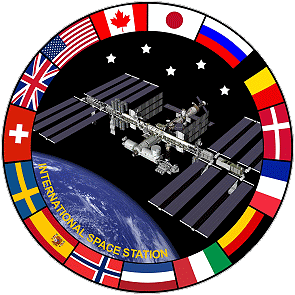 |
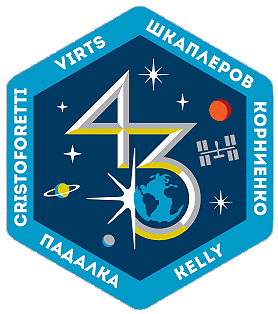 |
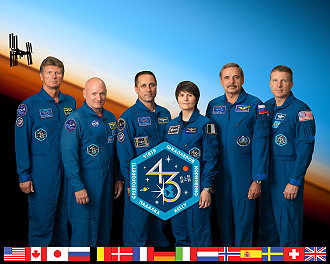 |
alternative crew photo |
|
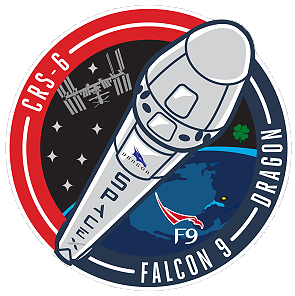 |
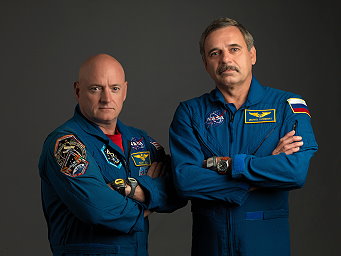
alternative crew photo |
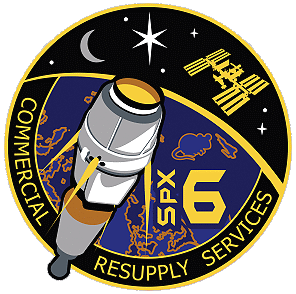 |
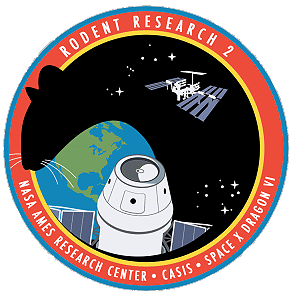 |
![]()
Crew, launch- and landing data
| No. | Nation | Surname | Given names | Position | Spacecraft (launch) |
Launch date |
Launch time |
Spacecraft (landing) |
Landing date |
Landing time |
Mission duration |
Orbits |
| 1 | Virts | Terry Wayne, Jr. | ISS-CDR | Soyuz TMA-15M | 23.11.2014 | 21:01:13.881 UTC | Soyuz TMA-15M | 11.06.2015 | 13:43:56.7 UTC | 199d 16h 42m 43s | 3107 | |
| 2 | Padalka | Gennadi Ivanovich | Flight Engineer-1 | Soyuz TMA-16M | 27.03.2015 | 19:42:57.549 UTC | Soyuz TMA-16M | 12.09.2015 | 00:51:30.1 UTC | 168d 05h 08m 34s | 2619 | |
| 3 | Korniyenko | Mikhail Borisovich | Flight Engineer-2 | Soyuz TMA-16M | 27.03.2015 | 19:42:57.549 UTC | Soyuz TMA-18M | 02.03.2016 | 04:25:50.5 UTC | 340d 08h 42m 54s | 5356 | |
| 4 | Kelly | Scott Joseph | Flight Engineer-3 | Soyuz TMA-16M | 27.03.2015 | 19:42:57.549 UTC | Soyuz TMA-18M | 02.03.2016 | 04:25:50.5 UTC | 340d 08h 42m 54s | 5356 | |
| 5 | Shkaplerov | Anton Nikolayevich | Flight Engineer-4 | Soyuz TMA-15M | 23.11.2014 | 21:01:13.881 UTC | Soyuz TMA-15M | 11.06.2015 | 13:43:56.7 UTC | 199d 16h 42m 43s | 3107 | |
| 6 | Cristoforetti | Samantha | Flight Engineer-5 | Soyuz TMA-15M | 23.11.2014 | 21:01:13.881 UTC | Soyuz TMA-15M | 11.06.2015 | 13:43:56.7 UTC | 199d 16h 42m 43s | 3107 |
unofficial Backup Crew
| No. | Nation | Surname | Given names | Position |
| 1 | Lindgren | Kjell Norwood | ISS-CDR | |
| 2 | Ovchinin | Aleksei Nikolaevich | Flight Engineer | |
| 3 | Volkov | Sergei Aleksandrovich | Flight Engineer | |
| 4 | Williams | Jeffrey Nels | Flight Engineer | |
| 5 | Kononenko | Oleg Dmitriyevich | Flight Engineer | |
| 6 | Yui | Kimiya | Flight Engineer |
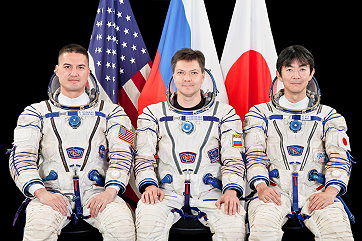 |
 |
 |
Expedition Report
|
ISS Expedition 43 began with the undocking of
spacecraft Soyuz TMA-14M on March 11, 2015 at 22:44:02
UTC. The former Expedition 42 (Aleksandr
Samokutyayev, Yelena
Serova and Barry
Wilmore) returned safely to Earth. With the arrival of Soyuz TMA-16M on March 28, 2015 the Expedition 43 became a six-person-crew. Soyuz TMA-16M carried Gennadi Padalka, Mikhail Korniyenko and Scott Kelly to the space station. Scott Kelly and Mikhail Korniyenko began their almost one-year-mission activities (1-Year Mission (1YM) Human Research Program (HRP) Science Operations) in the first days on their stay onboard when both crewmembers performed their first Fine Motor Skills test and Sleep log entries. They then continued with their one-year-mission protocols, performing another Sleep Log and a morning Reaction Self Test. The crew performed a second Reaction Self Test prior to their scheduled sleep period. In the Fine Motor Skills experiment, crew members perform a series of interactive tasks on a touchscreen tablet. The investigation is the first fine motor skills study to measure long-term microgravity exposure, different phases of microgravity adaptation, and sensorimotor recovery after returning to Earth gravity. The Sleep ISS-12 experiment monitors ambient light exposure and crew member activity and collects subjective evaluations of sleep and alertness to examine the effects of space flight and ambient light exposure on sleep during a year-long mission on the ISS. Reaction Self Test is a portable, five-minute task that enables astronauts to monitor the daily effects of fatigue on performance while in space. Sleep restrictions and residual effects from sleep medications, slam shifts that change the sleep/wake cycle, and effects from spacewalks can cause fatigue and degrade astronaut performance. Periodically during the mission, and in association with major events, an astronaut performs a reaction-time test on a computer to measure changes in responses. The sixth SpaceX cargo mission to the International Space Station under NASA's Commercial Resupply Services contract (SpaceX CRS-6 or SpX-6) was launched on April 14, 2015 from Space Launch Complex 40 at Cape Canaveral Air Force Station in Florida. The company's Falcon 9 rocket lifted off at 20:10:41 UTC, carrying its Dragon cargo spacecraft to the station. Dragon was filled with more than 4,300 pounds (1,950 kg) of supplies and payloads, including critical materials to directly support about 40 of the more than 250 science and research investigations that will occur during the space station's Expeditions 43 and 44. Science investigations launching on Dragon include commercial and academic payloads in myriad disciplines, exploring new ways to possibly counteract the microgravity-induced cell damage seen during spaceflight; studying the effects of microgravity on the most common cells in bones; gathering new insight that could lead to treatments for osteoporosis and muscle wasting conditions; continuing studies into astronaut vision changes; and testing a new material that could one day be used as a synthetic muscle for robotic explorers of the future. Investigations include: A study of potential methods for counteracting cell damage that occurs in a microgravity environment: The Cell Shape and Expression research program will provide for the first time a reliable experimental model able to highlight the relationships between microgravity, cell shape and gene expression, which may also inform pharmacological ways to counteract microgravity-induced cell damages. Research to improve understanding of bone cells, which could lead to treatments for osteoporosis and muscle wasting conditions: Osteo-4 studies the effects of microgravity on the function of osteocytes, which are the most common cells in bone. These cells reside within the mineralized bone and can sense mechanical forces, or the lack of them, but researchers do not know how. Osteo-4 allows scientists to analyze changes in the physical appearance and genetic expression of mouse bone cells in microgravity. Continued studies into astronaut vision changes: Dragon also will deliver hardware to support an ongoing one-year crew study known as Fluid Shifts. More than half of American astronauts experience vision changes and alterations to parts of their eyes during and after long-duration spaceflight. The Fluid Shifts investigation measures how much fluid shifts from the lower body to the upper body, in or out of cells and blood vessels, and determines the impact these shifts have on fluid pressure in the head and changes in vision and eye structures. Tests on a new material that could one day be used as a synthetic muscle for robotics explorers of the future: Robots can perform tasks too repetitive, difficult or dangerous for humans. Robots built with synthetic muscle would have more human-like capabilities, but the material would have to withstand the rigors of space. This investigation tests the radiation resistance of an electroactivepolymer called Synthetic Muscle, developed by RasLabs, which can contract and expand like real muscles. The spacecraft also will deliver hardware needed for the installation of two International Docking Adapters scheduled for delivery on future SpaceX missions. Once installed, these adapters will enable commercial crew spacecraft to dock to the space station. Dragon spacecraft arrived at the space station on April 17, 2015. Expedition 43 Flight Engineer Samantha Cristoforetti used the station's 57.7-foot (17.6 meters) robotic arm to reach out and capture Dragon at 10:55 UTC. Commander Terry Virts supported Samantha Cristoforetti as they operated from the station's cupola. Dragon was installed to the Earth-facing port of the Harmony module at 13:29 UTC. Among the more experiments were: Fluid Shifts Before, During and After Prolonged Space Flight and Their Association with Intracranial Pressure and Visual Impairment (Fluid Shifts): Scientists believe fluid shifts into an astronaut's head during spaceflight lead to increased pressure in the brain. This also may cause pressure to the back of the eye, causing the eye to change shape. The Fluid Shifts investigation measures how much fluid moves from the lower body to the upper body, in or out of cells and blood vessels, and determines the impact these shifts have on fluid pressure in the head, changes in vision and eye structures. The study results will help improve researchers' understanding of how blood pressure in the brain affects eye shape and vision. This knowledge may benefit people on Earth with disease states that include swelling and pressure to the brain or who are confined to bed rest. Results also could help scientists develop preventive measures against changes in astronauts' vision and eye damage. Biochemical Profile (Biochem Profile): Another One-Year Mission study will allow for quicker response to researchers' requests for spaceflight data about the effects of microgravity on human physiology. Through the collection, processing and storage of crew member blood and urine samples, the Biochem Profile investigation will establish a database of biomedical data to be shared among multi-disciplinary researchers and medical operations that assess the effects of spaceflight on humans. This data can be used to provide information about medical risks during long-duration space travel and to evaluate potential countermeasures established to protect crew health. With greater understanding of how various physiological systems respond to changing gravity conditions, physicians may be able to design new treatments for people on Earth with limited mobility. Meteor Composition Determination (Meteor): The Meteor investigation, originally slated for delivery on the failed Orbital Cygnus Commercial Resupply Services-3 mission, will now be part of Expedition 43 research and will enable the first space-based observations of meteors entering Earth's atmosphere from space. Meteor uses high-resolution video and image analysis of the atmosphere to determine the physical and chemical properties of the meteoroid dust, such as size, density and chemical composition. The study of meteoroid dust from the space station provides information about the parent comets and asteroids. Researchers investigate the elemental composition of meteors to better understand how the planets developed. Continuous measurement of meteor interactions with Earth's atmosphere could spot previously unforeseen meteors and help protect spacecraft and Earth from potential collisions with this celestial debris. Synthetic Muscle: Resistance to Radiation; Ras Labs-CASISISS Project for Synthetic Muscle: Resistance to Radiation (Synthetic Muscle): The Synthetic Muscle investigation tests a specific type of polymer developed by Ras Labs in Quincy, Massachusetts. The polymer contracts and expands similar to real muscle. Since robots can perform tasks too dangerous for humans in space, building robots with synthetic muscle could create more humanoid robots with greater dexterity. The synthetic muscle will be tested with a variety of additives and coatings aboard the space station to make sure it can withstand radiation exposure encountered in microgravity. Results from this study may allow researchers to design more durable robots for deep space travel and could improve robotics and prosthetics on Earth. In April 2015 Scott Kelly recorded a video, documenting observations using the Space Habitability Observation Reporting Tool (iSHORT) application, providing insights related to human factors and habitability. This video was of the hygiene areas onboard the ISS. Habitability assesses the relationship between crewmembers and their environment in order to better prepare for future longduration spaceflights to destinations, such as Near Earth Asteroids (NEA) and Mars. The ultimate goal is to understand how much habitable volume is required for vehicle internal design and layout, and if mission duration impacts the volume needed. Observations during the one year mission, as well as 6 month missions, can help spacecraft designers understand how much habitable volume is required, and whether a mission's duration impacts how much space crewmembers need. The iShort application will enable ground support teams and human factor engineers to study and evaluate the design of the ISS and use these results for future spacecraft. The Progress M-25M cargo ship departed the station on April 25, 2015. The Russian resupply ship, which arrived at the orbital laboratory in October 2014, undocked from the Pirs Docking Compartment at 06:41:14 UTC. After it undocked, the spacecraft moved to a safe distance from the station until the deorbit on April 26, 2015. Progress M-27M launched to the station on April 28, 2015 with almost three tons of food, fuel and supplies for the station's Expedition 43 crew. The spacecraft launched at 07:09:50 UTC from the Baikonur Cosmodrome in Kazakhstan. It was the 59th Progress transporter in the ISS program. The launch proceeded as planned, however, Russian flight controllers could not initially confirm the health of the freighter's systems and deployment of its Kurs rendezvous and other navigational antennas. As a result, the controllers opted for to a backup rendezvous plan with a targeted arrival on April 30, 2015. As the Progress passed over ground stations, the flight control team issued commands through a telemetry system aboard the spacecraft in an attempt to confirm that the navigation and rendezvous systems had deployed. But, due to sporadic telemetry, inconclusive data, and trouble uplinking commands, the controllers were unable to verify the status of the craft's systems. Flight controllers also confirmed that the vehicle had entered into a wild spin and have issued commands in an attempt to control it. In addition the spacecraft is in a lower orbit than planned. The spacecraft was not carrying any supplies critical for the United States Operating Segment (USOS) of the station. Both the Russian and USOS segments of the station continue to operate normally and are adequately supplied well beyond the next planned resupply flight. The next mission scheduled to deliver cargo to the station is the seventh SpaceX commercial resupply services mission targeted for launch no earlier than June 19, 2015. It will carry about 5,000 pounds (2,268 kg) of science investigations and supplies. Meanwhile Roscosmos reported that Progress M-27M maybe will make an uncontrolled re-entry between May 07 and May 11, 2015 if a last attempt to get contact with the freighter is not successful. Nine days after it spun out of control on its way to resupply the International Space Station, the Russian Progress M-27M spacecraft plunged back to Earth on May 08, 2015 at 02:04 UTC over the South Pacific to the west of the southern tip of South America. The cargo craft broke apart and burned up as it re-entered the Earth's atmosphere, though some debris may have made it to the surface. An investigation is ongoing as to what caused the Progress M-27M and its three tons of supplies to be lost. On May 06, 2015 at 05:15:00 UTC the ISS performed a nominal reboost using the Progress M-26M Rendezvous and Docking (R&D) thrusters. The reboost set up phasing requirements for Soyuz TMA-15M landing on May 14, 2015 (at this time planned). After the loss of Progress M-27M it was announced that the landing of Soyuz TMA-15M will be delayed for about a month. The launch of the next manned mission (Soyuz TMA-17M) will be two months later than planned. After delivering more than two tons of supplies and research to the International Space Station that will help prepare NASA astronauts and robotic explorers for future missions to Mars, the SpaceX Dragon cargo spacecraft left the orbital laboratory on May 21, 2015. The Dragon capsule, which arrived at the station April 17, 2015, was detached from the Earth-facing side of the station's Harmony module using the Canadarm2 robotic arm, operated by ground controllers at NASA's Johnson Space Center in Houston. NASA's Mission Control Center maneuvered Dragon into place and Expedition 43 robotic arm operator Scott Kelly gave the command for its 11:04 UTC release. The Dragon fired its thrusters three times to move to a safe distance from the station for its deorbit burn at approximately 15:49 UTC. The capsule splashed down in the Pacific Ocean at about 16:42 UTC with more than 3,100 pounds (1,400 kg) of cargo. This include science samples from human research, biology and biotechnology studies, physical science investigations and education activities sponsored by NASA and the Center for the Advancement of Science in Space (CASIS), the nonprofit organization that manages research aboard the U.S. national laboratory portion of the space station. On May 27, 2015, robotics flight controllers at the Mission Control Center at NASA's Johnson Space Center in Houston detached the large Permanent Multipurpose Module (PMM), used as a supply depot on the orbital laboratory, from the Earth-facing port of the Unity module and robotically relocate it to the forward port of the Tranquility module. This move cleared the Unity port for its conversion into the spare berthing location for U.S. cargo spacecraft; the Earth-facing port on Harmony is the primary docking location. Harmony's space-facing port currently is the spare berthing location for cargo vehicles, so this move frees that location to be used in conjunction with Harmony's forward port as the arrival locations for commercial crew spacecraft. NASA is in the process of reconfiguring the station to create primary and back up docking ports for U.S. commercial crew spacecraft currently in development by Boeing and SpaceX to once again transport astronauts from U.S. soil to the space station and back beginning in 2017. The primary and backup docking ports also will be reconfigured for U.S. commercial spacecraft delivering research, supplies and cargo for the crew. Expedition 43 Commander Terry Virts and Flight Engineer Scott Kelly supervised the unbolting of the module from Unity and its final attachment to Tranquility. They closed the hatch to the module on May 26, 2015 and will reopen it at its new location on the next day. The transformation of Harmony's space-facing and forward ports for crew arrivals will continue later this year, when a pair of International Docking Adapters (IDAs) will be delivered on the seventh and ninth NASA-contracted SpaceX cargo resupply missions. The IDAs will be attached to Pressurized Mating Adapters 2 and 3, which enable the spacecraft to equalize internal pressure with the ISS. The PMM, originally named "Leonardo" by the Italian Space Agency that supervised its manufacture, was one of three cargo modules used to haul supplies back and forth from the station during space shuttle assembly missions. The PMM was launched for the last time to the station on the final flight of the shuttle Discovery (STS-133) on February 24, 2011, and was installed on Unity five days later. The PMM is 22 feet (6.7 meters) long, 14 feet (4.3 meters) in diameter and weighs almost 11 tons. It has an internal volume of more than 2,400 cubic feet (68 cubic meters). Finally, the station command changed from US astronaut Terry Virts to Russian cosmonaut Gennadi Padalka. With undocking of Soyuz TMA-15M, carrying Anton Shkaplerov, Samantha Cristoforetti and Terry Virts, on June 11, 2015 at 10:20:05 UTC the Expedition 43 concluded and the new ISS Expedition 44 began. During the stay on board of the ISS the crews of Expeditions 43 / 44 carried out the following scientific experiments: 3DA1 Camcorder (Panasonic 3D Camera) ACE-H-1 (Advanced Colloids Experiment-Heated-1) AMO-TOCA (Autonomous Mission Operations TOCA Autonomous Operations Project) AMS-02 (Alpha Magnetic Spectrometer - 02) ATOMIZATION (Detailed validation of the new atomization concept derived from drop tower experiments--Aimed at developing a turbulent atomization simulator) Aniso Tubule (Roles of cortical microtubules and microtubule-associated proteins in gravity-induced growth modification of plant stems) Area PADLES (Area Passive Dosimeter for Life-Science Experiments in Space) Astro Palate (Factors Contributing to Food Acceptability and Consumption, Mood and Stress on Long-Term Space Missions) BCAT-KP-1-Critical Point ( Binary Colloidal Alloy Test Low Gravity Phase Kinetics-Critical Point) BCAT-KP1-Shelf Life (Binary Colloidal Alloy Test Low Gravity Phase Kinetics-1-Product Shelf Life) BP Reg (A Simple In-flight Method to Test the Risk of Fainting on Return to Earth After Long-Duration Space Flights) Biochem Profile (Biochemical Profile) Biological Rhythms 48hrs (The effect of long-term microgravity exposure on cardiac autonomic function by analyzing 48-hours electrocardiogram) Bisphosphonates ( Bisphosphonates as a Countermeasure to Space Flight Induced Bone Loss) Blind and Imagined (SLINK: move Short bLind plus shrink - Moving blind and throwing an imagery ball) Body Measures (Quantification of In-Flight Physical Changes - Anthropometry and Neutral Body Posture) CALET (CALorimetric Electron Telescope) CARTILAGE (CARTILAGE) CATS (Cloud-Aerosol Transport System) CEO (Crew Earth Observations) Capillary Beverage (Capillary Effects of Drinking in the Microgravity Environment) Cardio Ox (Defining the Relation Between Biomarkers of Oxidative and Inflammatory Stress and Atherosclerosis Risk in Astronauts During and After Long-duration Spaceflight) Check-Saliva (Salivary Markers of Metabolic Changes during Space Missions) Circadian Rhythms (Circadian Rhythms) Cognition (Individualized Real-Time Neurocognitive Assessment Toolkit for Space Flight Fatigue) DOSIS-3D (Dose Distribution Inside the International Space Station - 3D) Drain Brain (Strain-gauge Plethysmographic Analysis of the CErebral DRainage Experimented and Assessed in the Micro-gravitational Setting) Dynamic Surf (Experimental Assessment of Dynamic Surface Deformation Effects in Transition to Oscillatory Thermo capillary Flow in Liquid Bridge of High Prandtl Number Fluid) EDOS (Early Detection of Osteoporosis in Space) EML Batch 1 - CCEMLCC Experiment (EML Batch 1 - CCEMLCC Experiment) EML Batch 1 - COOLCOP Experiment (EML Batch 1 - COOLCOP Experiment) ESA-EPO-Cristoforetti (European Space Agency-Education Payload Operations-Convection-Cristoforetti) ESA-Haptics-1 (ESA-Haptics-1) Embryo Rad (Lifetime Heritable Effect of Space Radiation on Mouse embryos Preserved for a long-term in ISS) Energy (Astronaut's Energy Requirements for Long-Term Space Flight) Exerc-Orthostatic Tolerance (Structured Exercise Training as Countermeasure to Space Flight-Induced Orthostatic Intolerance) FLEX-2 (Flame Extinguishment Experiment - 2) Field Test (Recovery of Functional Sensorimotor Performance Following Long Duration Space Flight) Fine Motor Skills (Effects of Long-Duration Microgravity on Fine Motor Skills: 1 year ISS Investigation ) Fluid Shifts (Fluid Shifts Before, During and After Prolonged Space Flight and Their Association with Intracranial Pressure and Visual Impairment) Force Shoes (In-flight Demonstration of Portable Load Monitoring Devices-Phase I: XSENS ForceShoe™) Functional Task Test (Physiological Factors Contributing to Postflight Changes in Functional Performance) Group Combustion (Elucidation of Flame Spread and Group Combustion Excitation Mechanism of Randomly-distributed Droplet Clouds) HDEV (High Definition Earth Viewing) HREP-HICO (HICO and RAIDS Experiment Payload - Hyperspectral Imager for the Coastal Ocean) HREP-RAIDS (HICO and RAIDS Experiment Payload - Remote Atmospheric and Ionospheric Detection System (RAIDS)) Habitability (Habitability Assessment of International Space Station) Hip QCT (Feasibility Study: QCT Modality for Risk Surveillance of Bone - Effects of In-flight Countermeasures on Sub-regions of the Hip Bone) IMAX (IMAX Documentary film: A PERFECT PLANET) ISERV (ISS SERVIR Environmental Research and Visualization System) ISS Ham Radio (ARISS) (International Space Station Ham Radio (also known as Amateur Radio on the International Space Station (ARISS))) ISS RapidScat (ISS-RapidScat) ISSpresso (ISSpresso) Intervertebral Disc Damage (Risk of Intervertebral Disc Damage after Prolonged Space Flight) JAXA PCG (Japan Aerospace Exploration Agency Protein Crystal Growth) JAXA PCG Demo (JAXA High Quality Protein Crystal Growth Demonstration Experiment) JAXA-Commercial (Japan Aerospace Exploration Agency - Commercial Payload Program) Journals (Behavioral Issues Associated with isolation and Confinement: Review and Analysis of Astronaut Journals) LONESTAR (Low Earth Orbiting Navigation Experiment for Spacecraft Testing Autonomous Rendezvous and Docking) MAXI (Monitor of All-sky X-ray Image) MCE (Multi-mission Consolidated Equipment) MVIS Controller-1 (MVIS Controller 1) Manual Control (Assessment of Operator Proficiency Following Long-Duration Space Flight) Marangoni-UVP (Spatio-temporal Flow Structure in Marangoni Convection) Medical Consumables Tracking (Medical Consumables Tracking) Meteor (Meteor Composition Determination) Microbe-IV (Microbiological monitoring in the International Space Station-KIBO) Microbial Observatory-1 ( Microbial Tracking Payload Series) Microbiome (Study of the Impact of Long-Term Space Travel on the Astronauts' Microbiome) Multi-Gas Monitor (Multi-Gas Monitor) Myco (Mycological Evaluation of Crew Exposure to ISS Ambient Air) NIH-Osteo ( Gravitational Regulation of Osteoblast Genomics and Metabolism) NanoRacks-AHS-Pollen Propulsion (NanoRacks-Ambassador High School-Pollen Propulsion in a Microgravity Environment) NanoRacks-Planet Labs-Dove (NanoRacks-Planet Labs-Dove) NanoRacks-Planetary Resources-Arkyd-3 (NanoRacks-Planetary Resources-Arkyd-3) Nematode Muscles (Alterations of C. elegans muscle fibers by microgravity) NeuroMapping (Spaceflight Effects on Neurocognitive Performance: Extent, Longevity, and Neural Bases) OASIS (Observation & Analysis of Smectic Islands in Space) OPALS (Optical PAyload for Lasercomm Science) Ocular Health (Prospective Observational Study of Ocular Health in ISS Crews) Osteo-4 (Osteocytes and mechano-transduction) PK-4 (Plasma Krystall-4) PS-TEPC (Establishment of dosimetric technique in the International Space Station (ISS) with Position Sensitive Tissue Equivalent Proportional Chamber) Plant Gravity Sensing (Utilization of the micro gravity condition to examine the cellular process of formation of the gravity sensor and the molecular mechanism of gravity sensing) Plant Rotation (Plant circumnutation and its dependence on the gravity response) RJR (Augmented) Microbial Sampling (RJR (Augmented) Microbial Sampling) RRM-Phase 2 (Robotic Refueling Mission Phase 2) Radi-N2 (Radi-N2 Neutron Field Study) Radiation Environment Monitor (Radiation Environment Monitor) Reaction Self Test (Psychomotor Vigilance Self Test on the International Space Station) Repository (National Aeronautics and Space Administration Biological Specimen Repository) Robonaut (Robonaut) Rodent Research-2 (NASA #1) ( Rodent Research-2 (NASA #1) Impact of Spaceflight on Primary and Secondary Antibody Responses ) Rodent Research-2 (NASA #2) ( Rodent Research-2 (NASA #2) Implications for Elevated Intracranial Pressure ) SCAN Testbed (Space Communications and Navigation Testbed) SEDA-AP (Space Environment Data Acquisition Equipment - Attached Payload) SNFM (Serial Network Flow Monitor) SPHERES-Slosh (SPHERES-Slosh) SPHERES-Zero-Robotics ( Synchronized Position Hold, Engage, Reorient, Experimental Satellites-Zero-Robotics) Salivary Markers (The Effects of Long-Term Exposure to Microgravity on Salivary Markers of Innate Immunity) Sally Ride EarthKAM (Sally Ride Earth Knowledge Acquired by Middle School Students) Skin-B (Skin-B) Sleep ISS-12 (Sleep-Wake Actigraphy and Light Exposure on ISS-12) Solar-SOLACES (Sun Monitoring on the External Payload Facility of Columbus - SOLar Auto-Calibrating EUV/UV Spectrophotometers) Solar-SOLSPEC (Sun Monitoring on the External Payload Facility of Columbus -Sun Monitoring on the External Payload Facility of Columbus -SOLar SPECtral Irradiance Measurements) Space Aging (Study of the effects of space flight on the aging of C. elegans) Space Headaches (Space Headaches) Space Pup (Effect of space environment on mammalian reproduction) SpinSat (SpinSat) Sprint (Integrated Resistance and Aerobic Training Study) Stem Cells (Study on the Effect of Space Environment to Embryonic Stem Cells to Their Development) Story Time From Space (Story Time From Space) Synergy (The elucidation of the re-adaptation on the attitude control after return from long term space flight) Synthetic Muscle (Synthetic Muscle: Resistance to Radiation; Ras Labs-CASIS-ISS Project for Synthetic Muscle: Resistance to Radiation) Telomeres (Assessing Telomere Lengths and Telomerase Activity in Astronauts) Training Retention (Effects of Long-Duration Spaceflight on Training Retention: 1-Year ISS Investigation) TripleLux-A (Gene, Immune and Cellular Responses to Single and Combined Space Flight Conditions - A) UBNT (Ultrasonic Background Noise Test) UPA (Urine Processor Assembly Hardware Improvements) V-C REFLEX (Plastic alteration of vestibulo-cardiovascular reflex and its countermeasure) VIABLE ISS (eValuatIon And monitoring of microBiofiLms insidE International Space Station) Veg-01 (Veggie hardware validation test) Vessel ID System (Vessel ID System) Wearable Monitoring (Wearable System for Sleep Monitoring in Microgravity) Windows on Earth (Windows on Earth) |
Photos
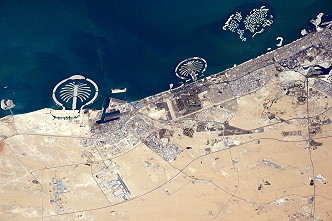 |
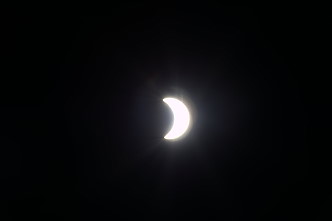 |
 |
 |
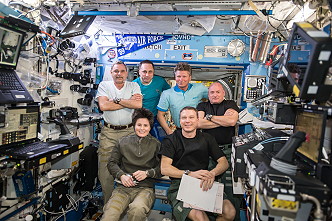 |
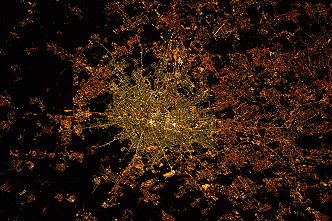 |
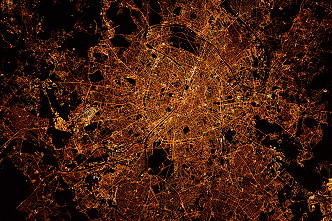 |
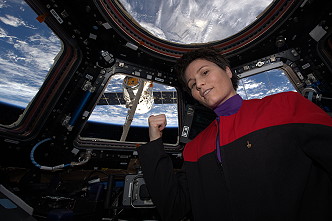 |
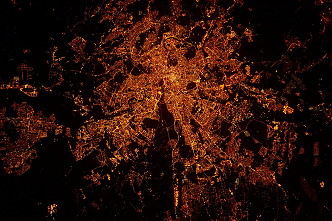 |
 |
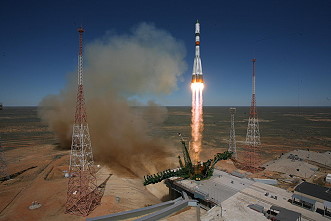 |
 |
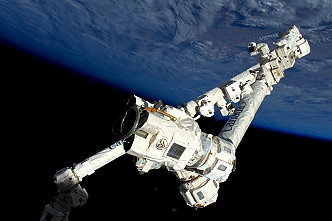 |
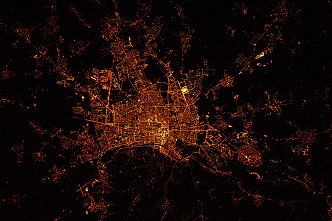 |
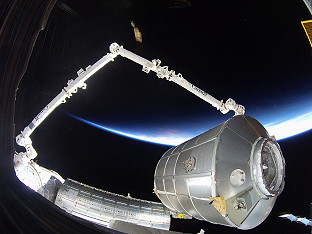 |
 |
 |
|
more Earth observation photos |
|
more onboard photos |
|
| © |  |
Last update on December 15, 2020.  |
 |